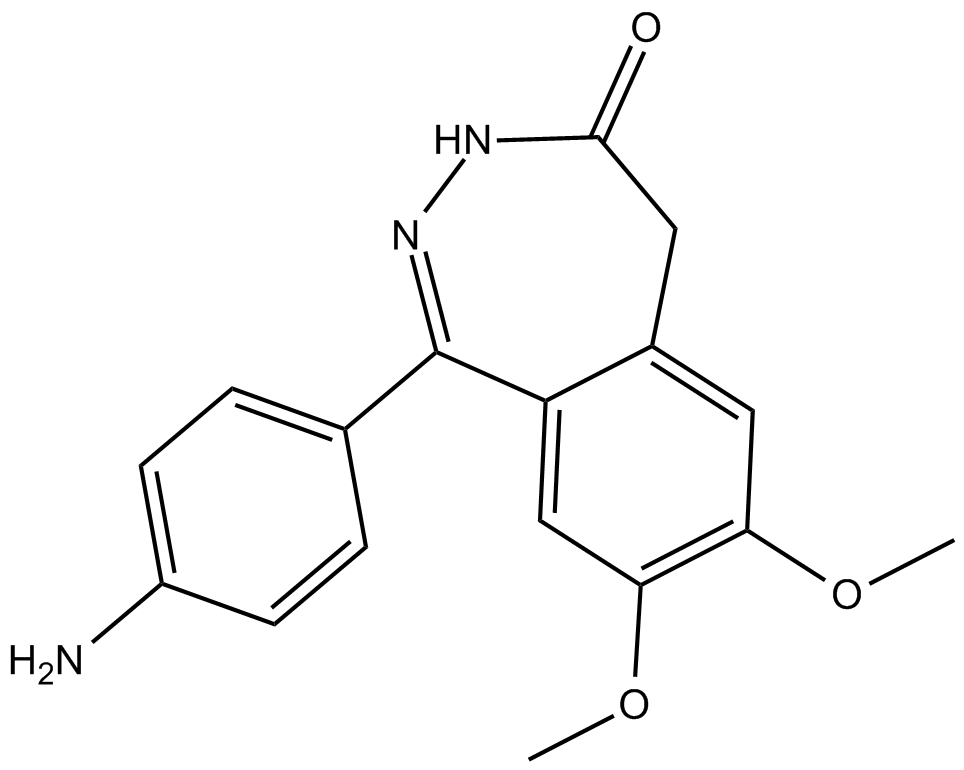CFM-2 |
| Catalog No.GC18079 |
AMPA antagonist
Products are for research use only. Not for human use. We do not sell to patients.

Cas No.: 178616-26-7
Sample solution is provided at 25 µL, 10mM.
CFM-2 is a selective non-competitive AMPAR antagonist.IC50 value:Target: AMPAR antagonistin vitro: AMPA antagonists GYKI 52466 and CFM-2 inhibit the extracellular signal regulated kinase (ERK1/2) pathway, CFM-2 reduced phosphorylation of cAMP-responsive element binding protein (CREB), suppressed expression of cyclin D1, upregulated the cell cycle regulators and tumor suppressor proteins p21 and p53 and decreased number of lung adenocarcinoma cells in G2 and S phases of the cell cycle.in vivo: Pretreatment with CFM-2 delayed the progression of seizure rank during repeated administration of pentylentetrazole. At the end of the period of repeated pentylentetrazole treatment (6 weeks) the mean seizure score was 0 in vehicle treated controls, 4.3 in animals treated with vehicle + pentylentetrazole, 2.2 in rats treated chronically with CFM-2 (20 micromol kg(-1) i.p.) + pentylentetrazole and 1.0 in rats treated repeatedly with CFM-2 (50 micromol kg(-1) i.p.) + pentylenetetrazole. CFM-2 was also able to antagonize the long-term increase in sensitivity of the convulsant effects of GABA function inhibitors in pentylentetrazole-kindled animals [1]. CFM-2 has been proven to possess anticonvulsant activity in various models of seizures [2]. Intrathecal application of two selective non-competitive AMPAR antagonists, CFM-2 (25 and 50 microg) and GYKI 52466 (50 microg), significantly attenuated mechanical and thermal hypersensitivities on the ipsilateral hind paw at 2 and 24 h post-CFA injection. Neither CFM-2 nor GYKI 52466 affected the contralateral basal responses to thermal and mechanical stimuli [4].
References:
[1]. De Sarro G, et al. Effects of some AMPA receptor antagonists on the development of tolerance in epilepsy-prone rats and in pentylenetetrazole kindled rats. Eur J Pharmacol. 1999 Mar 5;368(2-3):149-59.
[2]. Rizzo M, et al. Determination of new 2,3-benzodiazepines in rat plasma using high-performance liquid chromatography with ultraviolet detection. J Chromatogr B Biomed Sci Appl. 1999 Aug 20;731(2):207-15.
[3]. Stepulak A, et al. AMPA antagonists inhibit the extracellular signal regulated kinase pathway and suppress lung cancer growth. Cancer Biol Ther. 2007 Dec;6(12):1908-15.
[4]. Park JS, et al. Role of spinal cord alpha-amino-3-hydroxy-5-methyl-4-isoxazolepropionic acid receptors in complete Freund's adjuvant-induced inflammatory pain. Mol Pain. 2008 Dec 30;4:67.
Average Rating: 5 (Based on Reviews and 14 reference(s) in Google Scholar.)
GLPBIO products are for RESEARCH USE ONLY. Please make sure your review or question is research based.
Required fields are marked with *




















